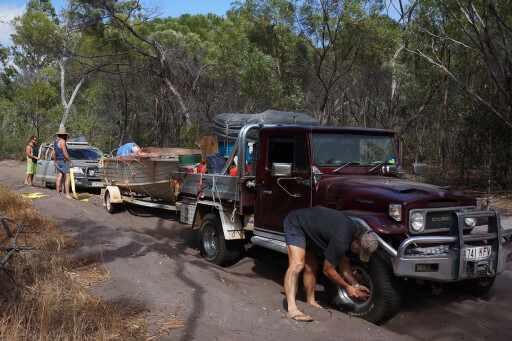
IT’S another touring season and, up north, from Fraser Island in the east to North West Cape and Steep Point in the west, people will be out flogging their four-wheel drives along sandy tracks – and, in the process, they’ll stuff up the tracks because they haven’t let their tyre pressures down.
It’s enough to drive anyone who does the right thing, or any of our land managers, bloody crazy! Out on our desert tracks, whether it is across the Simpson Desert, the Canning Stock Route or along the Anne Beadell Highway, half the reason the tracks are so corrugated and have whoopty doos on every sand dune is because people don’t let their tyres down.
With the power and torque from modern engines, many people just plant their foot, spin the wheels and kangaroo hop their way to the top of the dune.
There is no bloody need for it! Lowering tyre pressures, especially in sand, is the best thing you can do to make it easy on yourself and your vehicle – and, in the process, you’ll help save the track.
If you’re on a beach and not too heavily loaded, 20psi (or 140kpa) is generally a good starting point.
 If you’re driving the Canning Stock Route and have 200 litres of fuel on board, along with water, food for three weeks and camping gear for the family, then 25psi (175kpa) would be more appropriate. If there is a chance of a stake or a rock taking out a sidewall, then 25psi makes even more sense. It just takes a bit of compromise.
If you’re driving the Canning Stock Route and have 200 litres of fuel on board, along with water, food for three weeks and camping gear for the family, then 25psi (175kpa) would be more appropriate. If there is a chance of a stake or a rock taking out a sidewall, then 25psi makes even more sense. It just takes a bit of compromise.
The idea of lowering tyre pressures is to allow the tyre to deflate and increase its contact with Mother Earth – mainly in length but also in width. Some people reckon you should measure the length of the contact area with a ruler but, as I don’t carry a measuring stick with me on any of my journeys, a tyre gauge is fine.
It all does the same thing anyway, and I’ve yet to see anyone use a ruler when out bush, unless they’re spruiking about it on a video or in a magazine.
Info on tyre pressures and how the contact area of the tyre increases as air pressure drops can be found by reading the Cooper Tires’ Tyre Pressures Guide, found at www.coopertires.com.au
 One of the things that continually surprises me – and trust me, I’ve been bogged more times than I can count – is the difference taking a few pounds out of a set of tyres can make to a vehicle and/or a bogging.
One of the things that continually surprises me – and trust me, I’ve been bogged more times than I can count – is the difference taking a few pounds out of a set of tyres can make to a vehicle and/or a bogging.
So, if you’re at 20psi and become bogged, drop your tyre pressures down to approximately 17 or 18psi and try driving out on that – don’t just spin the wheels.
You can go lower with air pressure but, as you do, remember it becomes easier for a tyre to be parted from the rim, or for the seal between tyre and rim to be broken for just a second or two. The result is the same – a very flat tyre – and that doesn’t help you regardless of whether you are on a soft sand beach or halfway up a dune.
Tyre pressures also play an important part when you are driving on a gravel road like the Strzelecki Track or a steep rock strewn mountain route in the Victoria High Country. For example, when I’m on the blacktop in my Toyota Cruiser or my Nissan Patrol towing my camper and set-up for a trip, my tyre pressures will be around 38 to 40psi (265-280kpa), front and rear.
Once I hit the gravel, I’ll drop six to eight psi from each tyre and maybe a couple more if the road is badly corrugated. If the track slows or becomes chopped up, I’ll go down a couple more psi. Once again, the Cooper Tires’ Guide mentioned earlier will give you a good idea of what you need.
This means you will need to carry a tyre pressure gauge, a tyre deflator and an air compressor on all your trips. So go get them... now!

COMMENTS